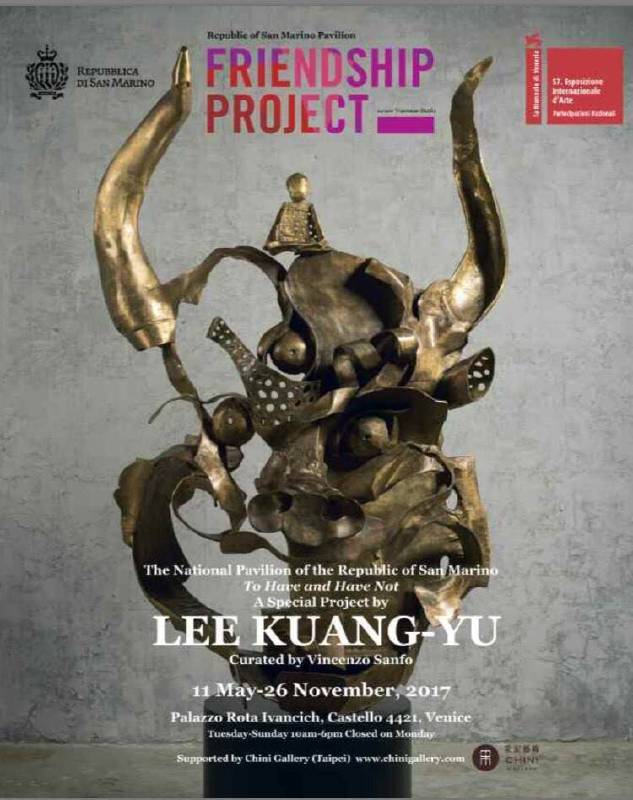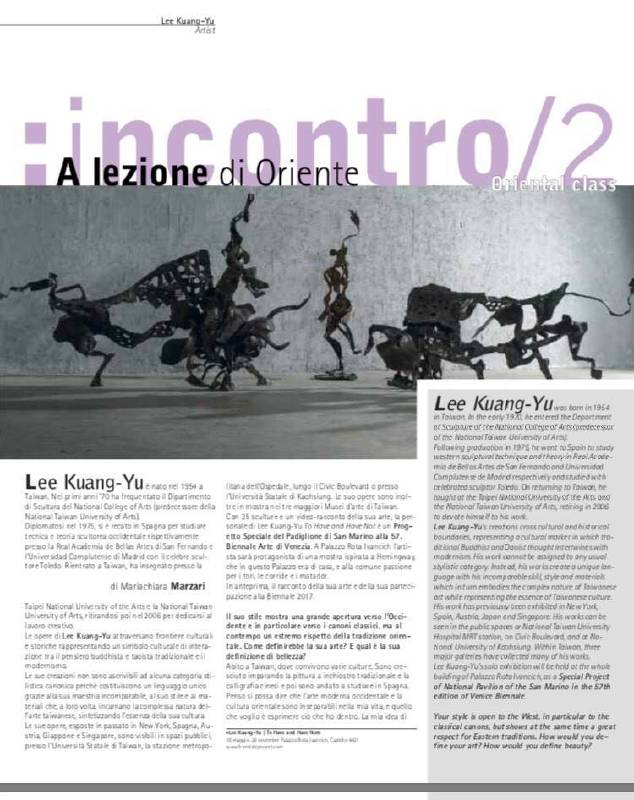采泥藝術:【Venews 2017.04】A lezione di Oriente │Lesson in the Orient
2017-04-30|撰文者:采泥藝術│Chini Gallery
Venews 2017.04
A lezione di Oriente │Lesson in the Orient
/Marzari
1.您的藝術風格具有西方古典氣質,但同時又體現對東方傳統的傳承。您如何定義您的藝術?以及如何定義美?
我生活在多元文化的台灣,從小學習傳統水墨畫和書法,後來又到西班牙留學,可以說西方古典文化、現代西方藝術與東方文化,都成為我身上不可分離的一部分,我只是遵從自己的內心將之表達而已。我的藝術觀有點類似東方文化中的一種自然流動的生命觀,我從中體會到大自然的“自我生成”之奧秘,故能從萬花筒中看到各種現象,它也是藝術創造的源泉。我認為沒有固定於古代、現代,或西方、東方的,一成不變的美或價值。
2.歷史上或當代哪些藝術大師影響過您的藝術經歷?說一二個具體的名字。
在我的成長過程中有很多大師扮演過重要的角色,比如米開朗基羅,羅丹,畢卡索,賈科梅蒂等等。特別是立體派的“解構”和“集成”等創作觀念啟發我對雕塑空間的重新認識。後來更為重要的是,我從東方文化中汲取營養,例如建築、廟宇之浮雕,傳統工藝器物,東方園林,乃至佛教及道家文化等等。
3.您的雕塑作品中,很多方面在不同程度上互相聯結:石膏、美學、空間層次、人像。你如何理解這些元素之間的平衡?
我認為觀看雕塑要有新的方式,最好能不斷的將人的理性和感性同時調動,具體來說,我的雕塑創造了一種空與滿,虛與實相互對比的遊戲,通過雕塑上的空洞及其產生的陰影,產生了很多虛擬的空間,觀眾在看這個雕塑時,會通過他們的眼睛把這些虛擬的空間去整合出來。我的雕塑的各個組成元素就是在這個創作理念的層面上達到了平衡,在空間的穿梭中,既有細膩的情感投射,亦有我所主張的東方美學表達。
4.我認為您處於研究美學、哲學和現實的核心。您現在對生活和藝術有什麼想法?您對“當代”有什麼看法。
我的雕塑是我在臺北汐止山中的花園,與自然的朝夕相處中領悟與創作出來的。在那裡,我的作品與親手種下的樹木放在一起,像是一個永恆的空間。我認為好的藝術,其價值不因時空的轉變而改變。但這並不表示我不關心當代的問題。當代社會的各種暴力讓全世界人們感到無奈與焦慮,我覺得缺失的東西可能是我們如何去面對自己的內心,這次我在威尼斯雙年展聖馬力諾國家館的個展主題─“有無之際”(To Have and Have Not)取自美國作家海明威的小說,海明威作為“迷惘的一代”代表作家,他所描寫的時代症候在我們今天同樣具有意義。
5.現在您的藝術來到了威尼斯。是什麼讓您燃起了熱情,是威尼斯這座城市,是雙年展,還是舉辦您展覽的宮邸?
我的藝術熱情一直是我生命的一部分。威尼斯這座城市和“海明威故居”啟發給我許多意象,我希望用我的語言方式去詮釋。我在拼湊對這個世界的意象,就像畢卡索在拼湊立體派的拼貼世界。
************************************
- Your style is open to the West, in particular to the classical canons, but shows at the same time a great respect for Eastern traditions. How would you define your art? How would you define beauty?
I live in Taiwan where the culture is diverse. I grew up learning traditional Chinese ink painting and calligraphy, and also studied in Spain later. I guess it is fair to say that modern Western art and Eastern culture have become inseparable to my life. In fact, I only want to express what I feel within. My artistic concept is somewhat similar to the natural and fluid view on life in Eastern culture, in which I perceive nature's secret of "the creation of the self." It enables me to perceive all kinds of phenomena in this kaleidoscopic world, which has become the source of my art. In my opinion, beauty and its value is not unchanging and confined to ancient, modern, Western or Eastern aesthetics.
- Which Maestros of the past and the present influenced your art experience?
Since my youthful days, there have been many maestros who are important to me, including Michelangelo, Rodin, Picasso, Giacometti, etc. In particular, the Cubist concepts of deconstruction and assemblage have been inspiring in terms of my renewed understanding of the sculptural space. In a later period, what becomes more important is the nurturance of the Eastern culture, such as the relief of architecture and temple, traditional handicraft, Eastern garden, and Buddhist and Taoist culture.
- In your sculptures, we see different levels that are strongly tied to one another: the plastic, aesthetical, spatial level, and the human one as well. What is your idea of balance between these components?
In my opinion, we need new approaches to see sculpture. The best approach can constantly adjust and balance people's rationality and sensibility. To be more concrete, my sculpture presents a combination of void and fullness, an interplay between the virtual and the concrete. Through the sculpture's holes and the shadow they create, one can find many virtual spaces. When a spectator is looking at the sculpture, his or her eyes would automatically integrate these virtual spaces. The balance between various elements in my sculpture is achieved through this creative concept. In between the spaces, one finds delicate and subtle emotions as well as the Eastern aesthetics that my work embodies.
- Man at the centre of the research of aesthetics, philosophy, and reality. What is your idea of contemporary in life and in art?
My sculpture originates from and is created in my garden surrounded by mountains in Xizhi, Taipei, where I find inspiration and realization through immersing myself in nature. There, my works are placed with trees I planted. It is like an eternal space. For me, the value of good art does not change through time. However, it does not mean that I do not pay attention to contemporary issues. Nowadays, all kinds of violent behaviors have filled our contemporary society with helplessness and anxieties. I feel that what is missing might just be that we have not looked inward. The theme of my solo exhibition at the San Marino Pavilion at the Venice Biennale, To Have and Have Not, is inspired by Hemingway's novel. As one of the representative figures of the "Lost Generation," the symptoms of that era described by the novelist reveal equal significance to our present society.
- Your art arrives in Venice. What suggestions - the city, the Biennale, the Palazzo that houses your exhibition - lit up your fire?
My passion for art has always been a crucial part of my life. The city of Venice as well as "Hemingway's residence" have offered me many inspiring images. I hope I can interpret them through my vocabularies. The way I assemble the images of this world is similar to how Picasso has assembled and represented his Cubist view of the world.



